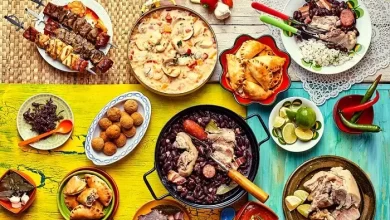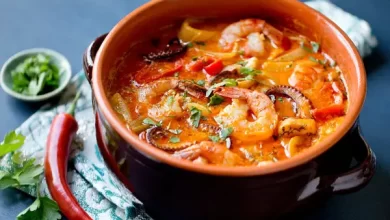A Culinary Tapestry: Exploring the Rich Flavors and Cultural Significance of Brazilian Cuisine
Brazilian Cuisine
Introduction:
Brazil, a nation renowned for its colorful history, varied scenery, and throbbing beats, has a gastronomic legacy that is just as fascinating and varied as its populace. Brazilian food is a diverse tapestry made from African, Portuguese, indigenous, and immigrant influences. Brazilian cuisine offers a gourmet adventure that symbolizes the size and diversity of the nation, from the tropical fruits of the Amazon to the savory delights of the churrascarias. This article explores the origins, components, and well-known recipes that comprise the intriguing realm of Brazilian gastronomy.
Historical Influences:
Brazilian food combines native ingredients and cooking methods with flavors introduced by African slaves, Portuguese colonists, and immigrants from all over the world. Staples like rice, wheat, and dairy goods were brought by the Portuguese, and African slaves brought a range of ingredients and culinary techniques, such as okra, palm oil, and other tubers.
Indigenous groups introduced exotic fruits, fish, and wildlife to the culinary scene because of their extensive understanding of the environment. Brazil’s culinary repertoire was further enhanced by the introduction of new products and cooking techniques as the nation welcomed immigrants from Europe, the Middle East, and Asia.
Key Ingredients:
- Manioc (Cassava): Manioc is a versatile root vegetable that is a mainstay in Brazilian cuisine. It is used to produce farinha, or cassava flour, which is an essential component of many meals. It’s used to make comfort food like tapioca and farofa.
- Feijoada: Feijoada, a robust black bean stew made with pig, sausage, and beef, is sometimes referred to as Brazil’s national cuisine. This meal, which is usually served with rice, collard greens, and orange slices, is a reflection of African culinary traditions.
- Açaí: Originating from the Amazon jungle, açaí berries have become a globally recognized superfood. In Brazil, açaí is typically eaten as a thick purple smoothie bowl with banana slices, granola, and other fruits on top.
- Churrasco: Churrasco, or Brazilian BBQ, is a meat lover’s paradise. A variety of meats are spiced and cooked slowly over an open flame, ranging from picanha (top sirloin) to linguiça (sausage). There are several barbecue restaurants called churrascarias that provide an unlimited meal.
- Moqueca: Moqueca, a fish stew from the coast, is made with coconut milk, palm oil, chiles, and other spices. It displays the variety of seafood found throughout Brazil’s lengthy coastline.


Iconic Brazilian Dishes:
- Feijoada: As was already noted, a staple of Brazilian cooking is feijoada. It is served in both homes and restaurants, and it represents the blending of tastes that characterizes the food culture of the country.
- Acarajé: Acarajé, a native of Bahia, is a deep-fried ball of black-eyed pea dough filled with caruru (shrimp and okra gumbo) and vatapá (a spicy paste made from bread, shrimp, and peanuts). It is a popular street dish with African origins.
- Coxinha: This well-liked snack is chicken shreds wrapped in a potato and wheat flour dough, formed into a drumstick form, breaded, and deep-fried. Snack stores and parties in Brazil are replete with coxinhas.
- Pão de Queijo: Made with cheese and cassava flour, these cheese bread balls have come to represent Brazilian food. Pão de queijo is soft and chewy and great for breakfast or as a snack.
- Caipirinha: Although not a food, the caipirinha is worthy of recognition. The ingredients for Brazil’s national cocktail are sugar, lime, and cachaça, a sugar cane spirit. It is a mainstay at social events because to its cultural relevance and refreshing flavor.
Regional Diversity:
Brazil’s immensity is seen in its varied regional cuisines as well as its scenery. With its considerable African influence, the northeastern area serves foods like moqueca and acarajé. The south is also known for its street-side churrascarias and barbecue culture. Exotic fish and fruits from the Amazon area are introduced into recipes like pato no tucupi and tacacá.
Culinary Festivals and Celebrations:
Brazilian festivals and festivities have a wide variety of flavors that highlight the country’s culinary diversity. For instance, street sellers sell a range of delights including coxinha, pastéis (deep-fried pastries), and churros in conjunction with the celebration of Carnival. Inspired by Portuguese and indigenous customs, Junina celebrations serve delicacies like pé-de-moleque (peanut brittle) and canjica (sweet corn pudding).


Conclusion:
Brazil’s geography, history, and culture are all reflected in its food. Its vivid and varied tastes, influenced by a wide range of factors, produce a rich and distinctive gastronomic experience. Brazilian cuisine is a unifying force that brings people together to enjoy the flavors and textures that make it a genuine gourmet marvel, whether they are found in the calm Amazon jungle or the busy streets of São Paulo. Brazil’s culinary legacy is still a source of pride as it embraces new influences and develops further, allowing the rest of the globe to delve deeper into the country’s rich gastronomic history.




